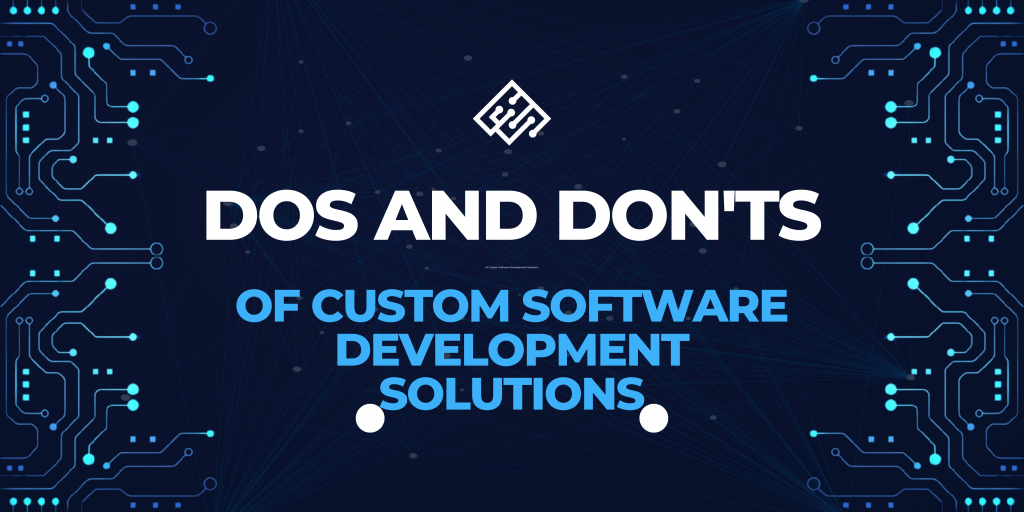Custom software development has become a strategic imperative for companies aiming to streamline operations, enhance efficiency, and gain a competitive edge. However, navigating the intricate path of custom software development presents its own set of challenges. To harness the full potential of custom software and avoid common pitfalls, it’s essential to follow a set of dos and don’ts. This article outlines the top recommendations for businesses venturing into the realm of bespoke software development.
Why Consider Custom Software?
Wondering if custom software development is the right move for your business? We understand – venturing into tailored development requires a significant commitment of time, finances, and internal resources. It’s indeed a significant decision, but don’t worry—we’re here to help.
Take a moment to reflect on your current systems and processes. Custom development might be the perfect fit in these cases:
- Tangled up in Manual Tasks: If you find yourself drowning in a sea of manual tasks, it’s time for a change. Custom software can automate these processes, giving you back precious time for more strategic endeavors.
- Outgrowing Your Software: Is your existing software gasping for breath as your business expands? Bespoke solutions can be tailored to your growing needs, ensuring your software keeps pace with your success.
- Conquering Complex Data: Wrestling with complex data that seems to have a mind of its own? Custom development can create a solution that tames the data chaos and makes it work for you, not against you.
- Data Transfer Challenges: If you’re stuck in the loop of manually transferring data between systems or platforms, it’s not just time-consuming – it’s inefficient and error-prone. Tailored software can seamlessly integrate your data, saving you from the tedious copy-paste dance.
- Craving Cost Efficiency: Who doesn’t want to save some bucks? Custom development allows for streamlined processes, potentially reducing costs, and boosting overall productivity. It’s not just about the investment; it’s about smart spending.
What Challenges Await in Bespoke Software Development?
Embarking on a custom software development journey holds immense potential for your business, promising heightened productivity, streamlined operations, and increased revenue. However, it’s crucial to recognize and navigate the intricate challenges that often accompany such projects. We aim to guide you through these hurdles, offering insights into the common challenges teams encounter, while empowering you to minimize risks effectively. Here are some key challenges that you can expect:
Navigating the Maze of Requirements:
In the initial stages, a common obstacle arises during the delicate task of outlining and specifying requirements. Conflicting, poorly documented or unclear requirements can lead to project delays, increased costs, and a final product that falls short of user needs. Mastering the art of crafting precise software requirements and conducting thorough stakeholder interviews, surveys and documentation is key to smoothing this potential roadblock.
Balancing the Books: The High Cost of Development:
Embarking on custom software development is a significant financial undertaking, involving both direct costs and opportunity costs in terms of time and personnel. A meticulous scoping and planning of the project is essential to avoid exceeding the budget. When the software development costs surpass initial estimates, projects can face formidable challenges.
The Quest for Expertise: Lack of In-House Know-How:
Many companies find themselves lacking the in-house expertise needed to navigate the complexities of the software development process and maintain quality assurance. This scarcity poses challenges, from the search for the right team members to hiring the appropriate software outsourcing company. The quest for expertise is pivotal in ensuring a smooth development journey.
Guarding the Castle: Data Security Concerns:
Ensuring the highest level of data security in custom software can be a labyrinth, especially when dealing with sensitive data structures. Nevertheless, it’s indispensable to uphold customer trust and comply with data protection regulations. Safeguarding your digital castle is non-negotiable in the realm of custom software development.
Bridging the Gap: Integration with Existing Systems:
Bespoke software often needs to seamlessly interact with current systems. This integration can pose challenges when existing systems are outdated or incompatible, demanding frequent adjustments for smooth operations. Bridging this gap requires strategic planning to ensure harmony between the old and the new.
Custom Software Development Solutions – Do’s
Having explored the common challenges in custom software development, let’s pivot towards proactive solutions to empower your journey. In this section, we’ll delve into key recommendations for businesses before the software development life cycle kicks off. Here are some crucial do’s:
1. Be Clear on Business Goals
Embarking on the journey of custom software development begins with a clear vision of your business goals. Before diving into the intricacies of development, take a moment to comprehend your business’s needs. Essentially, why are you seeking software? Without a profound understanding of the business processes you aim to optimize or the problems you intend to solve, crafting the right solution becomes an elusive task.
To illuminate your path towards the right solution, consider the following steps:
- Engage with Your Team: Conduct interviews with individuals currently involved in the targeted business processes. Whether they are users of existing software solutions or contributors to manual workflows, these conversations unveil insights and ensure accurate documentation of end-user needs and current process dynamics.
- Leverage Usage Reports: Dive into usage reports of your existing software tools. This exploration provides a detailed understanding of the ongoing processes within your current tools. It not only identifies aspects that need replication in the new solution but also highlights areas where optimization is possible.
2. Harness Existing Tools & Platforms
Smart businesses find a valuable ally in leveraging existing software infrastructure or off-the-shelf solutions. This strategic approach not only proves cost-effective but also empowers businesses to craft custom solutions precisely tailored to their needs.
By seamlessly integrating existing software solutions, businesses unlock a multitude of benefits:
- Cost Savings: This approach trims down the cost of development, allowing businesses to allocate resources more efficiently. Rather than starting from scratch, building upon existing infrastructure proves to be a financially savvy choice.
- Reliability Assured: Choosing to integrate with established software solutions provides a foundation for reliability. It ensures that your custom software operates on a proven and stable platform, reducing the likelihood of unexpected glitches.
- Added Value from Established Solutions: The beauty of leveraging existing tools lies in the added value they bring. By building upon well-established solutions, businesses inherit not just functionality but also the wisdom distilled from the usage of these tools over time.
3. Find Your Ideal Software Development Partner
Amidst a myriad of options, selecting the right software development company is pivotal to the success of your project. Here are key traits to prioritize in your search for the ideal partner:
- Tailored Experience: Seek a partner with a tailored portfolio, showcasing success with businesses of your size and industry. Connect with a custom software development company renowned for delivering impactful projects to clients akin to your unique needs.
- Expertise That Resonates: Assess not just technical prowess but also domain-specific expertise. Ensure your chosen ally possesses the knowledge and skills required to breathe life into your software idea. A shared understanding of your industry is the cornerstone of a successful collaboration.
- Communication Harmony: Communication is the heartbeat of collaboration. Opt for a development company that excels in clear and consistent communication. Accessibility and receptiveness to feedback ensure a harmonious partnership throughout the development journey.
- Guardians of Security: Safeguarding your business is paramount. Ensure your chosen partner incorporates robust security measures. This not only protects your data but also guarantees the overall safety of your business operations.

Custom Software Development Solutions – Don’ts
Exploring the landscape of custom software development reveals various routes, each with its complexities demanding astute management and judicious decision-making. In this section, we’ll illuminate the path for you by highlighting key pitfalls to steer clear of during your custom software development ventures.
1. Avoid Overcomplicating UX Design
An intricately designed user experience not only affects user satisfaction but also extends development timelines, inflating costs and introducing project management challenges. Embrace simplicity and prioritize user-centered design principles to enhance your project’s efficiency:
• Seek the most straightforward solutions aligned with user needs.
• Prioritize simplicity and intuitive design, focusing on core features.
• Utilize consistent and familiar design patterns for intuitive navigation, ensuring users can seamlessly interact with your software. Remember, user satisfaction is at the heart of effective UX design.
2. Handle User and Business Data Inappropriately
Safeguarding user and business data is a non-negotiable aspect of custom software development. Cutting corners on software security exposes businesses to financial repercussions, erodes customer trust, and tarnishes the company’s reputation. Prioritize secure software development practices and tools to shield against potential security breaches.
Investing in robust security measures not only protects against financial losses but also ensures compliance with industry regulations like the General Data Protection Regulation (GDPR). It’s crucial to be vigilant about potential risks when sharing sensitive information with a software development partner. While collaboration is essential, understanding the implications and thoroughly assessing the vendor’s commitment to data security is paramount to mitigate risks associated with data mismanagement or intellectual property mishandling.
3. Neglecting Integration Requirements
Every business comes with its own set of distinctive software integration requirements. While off-the-shelf software systems may offer integration services, they might not align perfectly with your business needs, lacking the flexibility or robustness required for handling complex data. Bespoke software development grants you the freedom to choose the existing software or enterprise applications that your new solution will integrate with. Seamless integration with other software tools not only enhances process efficiency but also reduces the burden of maintaining third-party integration tools.
It’s crucial to document all integration needs during the requirements gathering phase, implement them in the software development phase, and conduct thorough testing before deployment.
4. Delaying User Testing
A robust testing plan is a cornerstone of effective software development, and it’s imperative not to postpone it until the software is fully developed. Incorporate user testing at every stage of the development process to receive real-time feedback that can inform continuous improvements to the software’s design.
Collaborate closely with your software development company to formulate a comprehensive QA test plan, ensuring sufficient staffing for ongoing testing. Consider the following points during the testing phase:
- Systematic Operational Testing: Test all operational processes systematically, and if necessary, involve real users to ensure the functionality of essential business operations.
- Thorough Integration Testing: Ensure comprehensive testing of all integrations, confirming that the system seamlessly interacts with other systems or software used within your organization.
- Cross-Device Testing: Conduct testing on both desktop and mobile devices. If the development involves mobile apps, those should undergo thorough testing.
- Alignment with Requirements: Verify that the final software features align with the initial requirements list. While changes may have occurred during development, the testing team should ensure that the final software meets the specified requirements.
Conclusion
Embracing custom software development holds immense potential for your business, despite its inherent complexities. By heeding the recommended strategies outlined in the “Do’s” and steering clear of the pitfalls highlighted in the “Don’ts,” you position your enterprise to optimize return on investment, facilitate seamless project execution, and secure a coveted competitive edge within your industry. Stay guided, stay innovative, and unlock the transformative power of tailored software solutions tailored to elevate your business to new heights.
Ready to embark on your custom software development journey? Infobest, a leading provider of bespoke software development services, is here to help. Our software development consulting services involve close collaboration to understand your unique business challenges, map out a strategic solution, and build software to your specifications.

